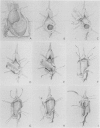Abstract
We reviewed our entire experience with composite graft replacement of the ascending aorta and aortic valve during a 63 month interval ending in December, 1979. Anuloaortic ectasia was the most common indication for operation, followed by aortic dissection (acute and chronic). Hospital mortality was 5% and was related to the preoperative functional status and the duration of intraoperative myocardial ischemia. Reoperation on the ascending aorta for reasons other than postoperative hemorrhage was required in five of the 82 hospital survivors (6%). By actuarial analysis, 90% of hospital survivors were free of any reoperation on the ascending aorta or aortic valve three years postoperatively, and 93% were free of reoperation related specifically to the composite graft. Pseudoaneurysms at the coronary ostia or distal aortic anastomosis were observed in five of 16 patients having postoperative angiography. One of the five patients has required reoperation. Follow-up has averaged 23.5 months (range: 0.2-60 months). Three year actuarial survival for the 86 patients was 81%, for 44 patients with anuloaortic ectasia was 88%, and for 31 patients with aortic dissection was 83%. Composite graft replacement of the ascending aorta and aortic valve is a satisfactory alternative to supracoronary graft replacement and aortic valve replacement. It offers the advantage of excluding all aneurysmal tissue from the aortic anulus to the innominate artery, thereby eliminating the potential for later development of aneurysms of the sinuses of Valsalva, a known complication of the supracoronary technique. It is the method of choice for patients with anuloaortic ectasia and cephalad displacement of the coronary ostia. It is suitable for many patients with acute or chronic dissection and for patients with sinuses of Valsalva aneurysms following previous operations on the ascending aorta or aortic valve.
Full text
PDF









Images in this article
Selected References
These references are in PubMed. This may not be the complete list of references from this article.
- Bentall H., De Bono A. A technique for complete replacement of the ascending aorta. Thorax. 1968 Jul;23(4):338–339. doi: 10.1136/thx.23.4.338. [DOI] [PMC free article] [PubMed] [Google Scholar]
- Blanco G., Adam A., Carlo V. A controlled surgical approach to annulo-aortic ectasia. Ann Surg. 1976 Feb;183(2):174–178. doi: 10.1097/00000658-197602000-00015. [DOI] [PMC free article] [PubMed] [Google Scholar]
- Breslow N. Covariance analysis of censored survival data. Biometrics. 1974 Mar;30(1):89–99. [PubMed] [Google Scholar]
- Conti V. R., Bertranou E. G., Blackstone E. H., Kirklin J. W., Digerness S. B. Cold cardioplegia versus hypothermia for myocardial protection. Randomized clinical study. J Thorac Cardiovasc Surg. 1978 Nov;76(5):577–589. [PubMed] [Google Scholar]
- DE BAKEY M. E., COOLEY D. A., CREECH O., Jr Surgical considerations of dissecting aneurysm of the aorta. Ann Surg. 1955 Oct;142(4):586-610; discussion, 611-2. doi: 10.1097/00000658-195510000-00005. [DOI] [PMC free article] [PubMed] [Google Scholar]
- ELLIS P. R., COOLEY D. A., DE BAKEY M. E. Clinical considerations and surgical treatment of annulo-aortic ectasia. Report of successful operation. J Thorac Cardiovasc Surg. 1961 Sep;42:363–370. [PubMed] [Google Scholar]
- Edwards W. S., Kerr A. R. A safer technique for replacement of the entire ascending aorta and aortic valve. J Thorac Cardiovasc Surg. 1970 Jun;59(6):837–839. [PubMed] [Google Scholar]
- Kouchoukos N. T., Karp R. B., Lell W. A. Replacement of the ascending aorta and aortic valve with a composite graft: results in 25 patients. Ann Thorac Surg. 1977 Aug;24(2):140–148. doi: 10.1016/s0003-4975(10)63723-x. [DOI] [PubMed] [Google Scholar]
- Mayer J. E., Jr, Lindsay W. G., Wang Y., Jorgensen C. R., Nicoloff D. M. Composite replacement of the aortic valve and ascending aorta. J Thorac Cardiovasc Surg. 1978 Dec;76(6):816–823. [PubMed] [Google Scholar]
- Miller D. C., Stinson E. B., Oyer P. E., Moreno-Cabral R. J., Reitz B. A., Rossiter S. J., Shumway N. E. Concomitant resection of ascending aortic aneurysm and replacement of the aortic valve: operative and long-term results with "conventional" techniques in ninety patients. J Thorac Cardiovasc Surg. 1980 Mar;79(3):388–401. [PubMed] [Google Scholar]
- Symbas P. N., Raizner A. E., Tyras D. H., Hatcher C. R., Jr, Inglesby T. V., Baldwin B. J. Aneurysms of all sinuses of Valsalva in patients with Marfan's syndrome: an unusual late complication following replacement of aortic valve and ascending aorta for aortic regurgitation and fusiform aneurysm of ascending aorta. Ann Surg. 1971 Dec;174(6):902–907. doi: 10.1097/00000658-197112000-00004. [DOI] [PMC free article] [PubMed] [Google Scholar]
- WHEAT M. W., Jr, WILSON J. R., BARTLEY T. D. SUCCESSFUL REPLACEMENT OF THE ENTIRE ASCENDING AORTA AND AORTIC VALVE. JAMA. 1964 May 25;188:717–719. doi: 10.1001/jama.1964.03060340015004. [DOI] [PubMed] [Google Scholar]
- Walker S. H., Duncan D. B. Estimation of the probability of an event as a function of several independent variables. Biometrika. 1967 Jun;54(1):167–179. [PubMed] [Google Scholar]
- Zubiate P., Kay J. H. Surgical treatment of aneurysm of the ascending aorta with aortic insufficiency and marked displacement of the coronary ostia. J Thorac Cardiovasc Surg. 1976 Mar;71(3):415–421. [PubMed] [Google Scholar]



